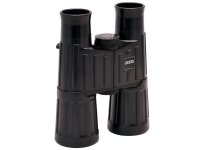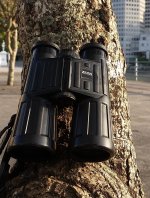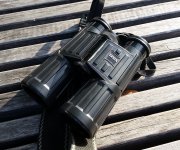This is a look back at some of my memories of using a pair of Zeiss Dialyts but first, an explanation of how I came to acquire the Dialyts.
My first binoculars were a pair of 1971 Swift Audubons which turned out to be totally unsuited to British weather, fogging up regularly and needing to be returned to the importer for cleaning. The biggest problem was the size of these and the Swift Saratogas that Troubadoris was using. Our transport was a Honda motorcycle equipped with pannier boxes for holiday luggage and the Swifts took up a huge percentage of the available volume so they had to go. We were tempted by the compact roof prism models from Zeiss and Leitz, and over the next 5 years I had two leatherette-covered Dialyt 10x40Bs, and a Leitz Trinovid 10x40B which developed too much free play in the focus. This put me off Leitz so I returned to Zeiss and replaced them with the subject of this reminiscence, a Zeiss Dialyt 10x40B GAT*.
The 10x40s were with me from 1986 to 2003 and captured many terrific wildlife observations. There was the male Dotterel and its chicks on top of a Cairngorm mountain who lifted one wing to preen underneath it and caused his three chicks to try to copy him. Later there was a Golden Eagle carrying a hare over Glen Feshie, a flock of 32 Red-billed Choughs on the Isle of Islay, our first Sea Eagle over Loch Eyenort and 8 Minke Whales from the ferry on the way to North Uist, and 101 encounters with European Otters in Hebridean Seas including a unique sighting of a mother and cub.
This sighting took place on the north-west coast of the Scottish mainland where we were overlooking a large sea-loch when we heard a weird faint squeaking coming from somewhere below us. At first we looked for a possible bird as the origin, but nothing was near enough so we moved closer to the cliff edge and looked straight down and were astonished to see a mother Otter holding a cub by the scruff of its neck with her teeth, and swimming strongly into the inner part of the sea loch only a few metres off-shore. We have seen many mother Otters with very small cubs before and since this incident but have never seen them being moved by the mother in this manner. It is often the case that the natal holt (where mothers give birth and where they look after the cub until it is ready to go to water for the first time) is some distance from the area of sea and shore that is the mother’s territory, and maybe the mother was taking her cub to a holt with better access to her foraging grounds
For our first White-tailed Sea-Eagle we were hiking across a hill-top on our way to a narrow sea-channel to do some rock-pooling when we paused to catch our breath and gaze at the amazing landscape below us, with the huge expanse of Loch Eyenort backed by South Uist’s biggest hills. To the north, we saw a huge bird, gliding towards us and as it glided lower and closer, we looked at each other in amazement as the full extent of this bird’s wingspan became apparent. It glided past us at a lower altitude than us, so that we were looking down on it. Those who wrote that Sea-Eagles have such huge wings that they look like flying barn doors were not exaggerating. Even the ‘fingers’ at the tips of its wings looked enormous and its comparatively small tail gave it a very different outline from Golden Eagle.
I took them on business trips all over Europe as well as to South Africa and Zimbabwe. In Zimbabwe I stayed at the Victoria Falls Hotel and went on a boat trip on the River Zambezi, up-river of the Falls, and visited an island there where the Dialyts gave me great views of hundreds of Egrets and Cormorants. On the opposite bank, a 100 metres downstream, I saw 3 Crocodiles lazing on some mud, and one of them lifted its head, slithered down the mud into the river then swam lazily towards us. It rounded the tip of the island where we were standing and floated stationary, with its eyes above the water line. Our ranger said the Croc’ knew we didn’t belong on the island and that we would probably make our way back to the mainland and it was hoping to grab one of us if the opportunity arose. We disappointed it by getting back into our boat and powering away.
It was during these Dialyt-years that I learned the basics about Hebridean Otters:
They forage at all heights of tide but more frequently at and near low tide. This reduces the time and energy spent going down from the surface and back up again and maximises time among the sea-weed banks and rocks where they try to ambush fish and crabs.
An average foraging dive in Hebridean waters takes around 15 seconds despite the fact that a spooked Otter can stay submerged for a lot longer than this.
Often, when returning to the surface after a dive, their momentum will propel them up to half their body length vertically out of the water. We call this ‘periscoping’ and seals never do this.
Sunlight will often glint off the smooth skin of a seal but this is a very rare occurrence with fur-covered Otters. This can be very useful if all you see in the far distance is a vague shape half-hidden by choppy waters and you are unsure if it is a Seal or an Otter.
Otters don’t have blubber insulation like seals so they need to regularly come out of the sea to warm up and they carry a fish with them to eat (often an extra-large one) and so pay-back the energy used in swimming away from and then returning to, their foraging site.
Otters forage by searching places fish and crabs hide among sea-weeds and stones so they move steadily through their chosen foraging area and rarely reverse their direction of travel as swimming among sites already visited would be a wasteful use of energy.
Otters need to regularly wash the salt from their fur to maintain its insulation properties and during these years we began to learn how to recognise these washing and drying sites.
Otters vary enormously in their reactions to the presence of humans. Some get used to this while others submerge and disappear at the first sight of a distant human. It is imperative not to disturb any foraging Otter as they are on a knife-edge balancing the need to get food to not only power their muscles when foraging, but also to maintain their body temperature in the sea and during the night. Maintaining body temperature, especially in winter, isn’t just about staying comfortable, it is about staying alive. This is doubly important for nursing mothers who also need successful foraging to produce milk to not only grow their cub but keep it warm too.
It was a result of the many such wonderful observations that I came to have such a fondness and respect for the Zeiss brand. The Dialyts weren’t perfect though. Their weakness (apart from the fact that my unit wasn’t phase corrected) was really that the objective lenses moved to achieve the focus, and as they moved in and out they naturally pumped air in and out of the internal volume. They never fogged up internally, but there were two consequences from this design. The most annoying was that a thin film of grease built around the edge of the objective mounts and on the sides of the optical tubes over which the objectives traversed. Using a brush to remove particles from the objectives was fraught with the risk of the brush picking up some lubricant and then painting it all over the objectives. If this happened, and it did, getting the grease off was an irritating and time-consuming ritual. In addition, and this is more of a curiosity than a problem, the pressure inside the bino, which the moving objectives had to overcome, was somewhat variable depending on how gas-tight the seal was around the objectives and I guess this varied according to how much grease built up around there. It was most noticeable when flying in an airliner when the variations in cabin pressure made themselves known by variations in effort needed to move the focus wheel. I especially noticed this when flying to South Africa on a 12 hour flight over the Atlantic when the plane turned east and I was trying to get a look at Namibia.
Although I was fond of the Dialyts I gradually became aware of two of the downsides to 10x magnification and that is the reduced depth of field and field of view compared with 8x, which is what Troubadoris had always used. She would often see things in the field of view of her Leitz Trinovid 8x40s that were either out of sight of my Dialyts or simply out of focus. This was frustrating but it taught me that more magnification did not always mean ‘seeing more’. Plus there was the discovery that the more we visited the west of Scotland (which had won over our hearts) and were exposed to weather systems drifting in off the Atlantic, the more I had to deal with strong gusting winds creating bino-shake which clearly didn’t affect Troubadoris as much with her 8x Leitzes.
So when I picked up a new Swarovski EL 8.5x42 WB in 2003 I was immediately attracted by its optical quality (it was phase corrected and my Dialyt wasn’t) and its field of view of 130m compared with the Zeiss’s 110m. Plus I have to admit that contemplating the step from 10x to 8.5x wasn’t quite as daunting as all the way down to 8x. I loved the Swarovski but was dismayed when after only a year the focus began to develop free play (backlash) and tight spots. Returning it to Absam for repair resulted in an improvement but not a return to the quality of focus that had been present when I bought it. Disappointed with Swarovski I was delighted when Zeiss introduced the Victory FLs and I bought an 8x42 that served me well for the next 9 years.
If any of you has a Dialyt 10x40 BGAT* with serial number 1894514 then you have the one that used to be mine! It has been fun looking back over some of the many memories the Dialyts gave me, and I hope you have enjoyed them too.
Stay safe, everybody, and Happy Holidays!
Lee
My first binoculars were a pair of 1971 Swift Audubons which turned out to be totally unsuited to British weather, fogging up regularly and needing to be returned to the importer for cleaning. The biggest problem was the size of these and the Swift Saratogas that Troubadoris was using. Our transport was a Honda motorcycle equipped with pannier boxes for holiday luggage and the Swifts took up a huge percentage of the available volume so they had to go. We were tempted by the compact roof prism models from Zeiss and Leitz, and over the next 5 years I had two leatherette-covered Dialyt 10x40Bs, and a Leitz Trinovid 10x40B which developed too much free play in the focus. This put me off Leitz so I returned to Zeiss and replaced them with the subject of this reminiscence, a Zeiss Dialyt 10x40B GAT*.
The 10x40s were with me from 1986 to 2003 and captured many terrific wildlife observations. There was the male Dotterel and its chicks on top of a Cairngorm mountain who lifted one wing to preen underneath it and caused his three chicks to try to copy him. Later there was a Golden Eagle carrying a hare over Glen Feshie, a flock of 32 Red-billed Choughs on the Isle of Islay, our first Sea Eagle over Loch Eyenort and 8 Minke Whales from the ferry on the way to North Uist, and 101 encounters with European Otters in Hebridean Seas including a unique sighting of a mother and cub.
This sighting took place on the north-west coast of the Scottish mainland where we were overlooking a large sea-loch when we heard a weird faint squeaking coming from somewhere below us. At first we looked for a possible bird as the origin, but nothing was near enough so we moved closer to the cliff edge and looked straight down and were astonished to see a mother Otter holding a cub by the scruff of its neck with her teeth, and swimming strongly into the inner part of the sea loch only a few metres off-shore. We have seen many mother Otters with very small cubs before and since this incident but have never seen them being moved by the mother in this manner. It is often the case that the natal holt (where mothers give birth and where they look after the cub until it is ready to go to water for the first time) is some distance from the area of sea and shore that is the mother’s territory, and maybe the mother was taking her cub to a holt with better access to her foraging grounds
For our first White-tailed Sea-Eagle we were hiking across a hill-top on our way to a narrow sea-channel to do some rock-pooling when we paused to catch our breath and gaze at the amazing landscape below us, with the huge expanse of Loch Eyenort backed by South Uist’s biggest hills. To the north, we saw a huge bird, gliding towards us and as it glided lower and closer, we looked at each other in amazement as the full extent of this bird’s wingspan became apparent. It glided past us at a lower altitude than us, so that we were looking down on it. Those who wrote that Sea-Eagles have such huge wings that they look like flying barn doors were not exaggerating. Even the ‘fingers’ at the tips of its wings looked enormous and its comparatively small tail gave it a very different outline from Golden Eagle.
I took them on business trips all over Europe as well as to South Africa and Zimbabwe. In Zimbabwe I stayed at the Victoria Falls Hotel and went on a boat trip on the River Zambezi, up-river of the Falls, and visited an island there where the Dialyts gave me great views of hundreds of Egrets and Cormorants. On the opposite bank, a 100 metres downstream, I saw 3 Crocodiles lazing on some mud, and one of them lifted its head, slithered down the mud into the river then swam lazily towards us. It rounded the tip of the island where we were standing and floated stationary, with its eyes above the water line. Our ranger said the Croc’ knew we didn’t belong on the island and that we would probably make our way back to the mainland and it was hoping to grab one of us if the opportunity arose. We disappointed it by getting back into our boat and powering away.
It was during these Dialyt-years that I learned the basics about Hebridean Otters:
They forage at all heights of tide but more frequently at and near low tide. This reduces the time and energy spent going down from the surface and back up again and maximises time among the sea-weed banks and rocks where they try to ambush fish and crabs.
An average foraging dive in Hebridean waters takes around 15 seconds despite the fact that a spooked Otter can stay submerged for a lot longer than this.
Often, when returning to the surface after a dive, their momentum will propel them up to half their body length vertically out of the water. We call this ‘periscoping’ and seals never do this.
Sunlight will often glint off the smooth skin of a seal but this is a very rare occurrence with fur-covered Otters. This can be very useful if all you see in the far distance is a vague shape half-hidden by choppy waters and you are unsure if it is a Seal or an Otter.
Otters don’t have blubber insulation like seals so they need to regularly come out of the sea to warm up and they carry a fish with them to eat (often an extra-large one) and so pay-back the energy used in swimming away from and then returning to, their foraging site.
Otters forage by searching places fish and crabs hide among sea-weeds and stones so they move steadily through their chosen foraging area and rarely reverse their direction of travel as swimming among sites already visited would be a wasteful use of energy.
Otters need to regularly wash the salt from their fur to maintain its insulation properties and during these years we began to learn how to recognise these washing and drying sites.
Otters vary enormously in their reactions to the presence of humans. Some get used to this while others submerge and disappear at the first sight of a distant human. It is imperative not to disturb any foraging Otter as they are on a knife-edge balancing the need to get food to not only power their muscles when foraging, but also to maintain their body temperature in the sea and during the night. Maintaining body temperature, especially in winter, isn’t just about staying comfortable, it is about staying alive. This is doubly important for nursing mothers who also need successful foraging to produce milk to not only grow their cub but keep it warm too.
It was a result of the many such wonderful observations that I came to have such a fondness and respect for the Zeiss brand. The Dialyts weren’t perfect though. Their weakness (apart from the fact that my unit wasn’t phase corrected) was really that the objective lenses moved to achieve the focus, and as they moved in and out they naturally pumped air in and out of the internal volume. They never fogged up internally, but there were two consequences from this design. The most annoying was that a thin film of grease built around the edge of the objective mounts and on the sides of the optical tubes over which the objectives traversed. Using a brush to remove particles from the objectives was fraught with the risk of the brush picking up some lubricant and then painting it all over the objectives. If this happened, and it did, getting the grease off was an irritating and time-consuming ritual. In addition, and this is more of a curiosity than a problem, the pressure inside the bino, which the moving objectives had to overcome, was somewhat variable depending on how gas-tight the seal was around the objectives and I guess this varied according to how much grease built up around there. It was most noticeable when flying in an airliner when the variations in cabin pressure made themselves known by variations in effort needed to move the focus wheel. I especially noticed this when flying to South Africa on a 12 hour flight over the Atlantic when the plane turned east and I was trying to get a look at Namibia.
Although I was fond of the Dialyts I gradually became aware of two of the downsides to 10x magnification and that is the reduced depth of field and field of view compared with 8x, which is what Troubadoris had always used. She would often see things in the field of view of her Leitz Trinovid 8x40s that were either out of sight of my Dialyts or simply out of focus. This was frustrating but it taught me that more magnification did not always mean ‘seeing more’. Plus there was the discovery that the more we visited the west of Scotland (which had won over our hearts) and were exposed to weather systems drifting in off the Atlantic, the more I had to deal with strong gusting winds creating bino-shake which clearly didn’t affect Troubadoris as much with her 8x Leitzes.
So when I picked up a new Swarovski EL 8.5x42 WB in 2003 I was immediately attracted by its optical quality (it was phase corrected and my Dialyt wasn’t) and its field of view of 130m compared with the Zeiss’s 110m. Plus I have to admit that contemplating the step from 10x to 8.5x wasn’t quite as daunting as all the way down to 8x. I loved the Swarovski but was dismayed when after only a year the focus began to develop free play (backlash) and tight spots. Returning it to Absam for repair resulted in an improvement but not a return to the quality of focus that had been present when I bought it. Disappointed with Swarovski I was delighted when Zeiss introduced the Victory FLs and I bought an 8x42 that served me well for the next 9 years.
If any of you has a Dialyt 10x40 BGAT* with serial number 1894514 then you have the one that used to be mine! It has been fun looking back over some of the many memories the Dialyts gave me, and I hope you have enjoyed them too.
Stay safe, everybody, and Happy Holidays!
Lee












